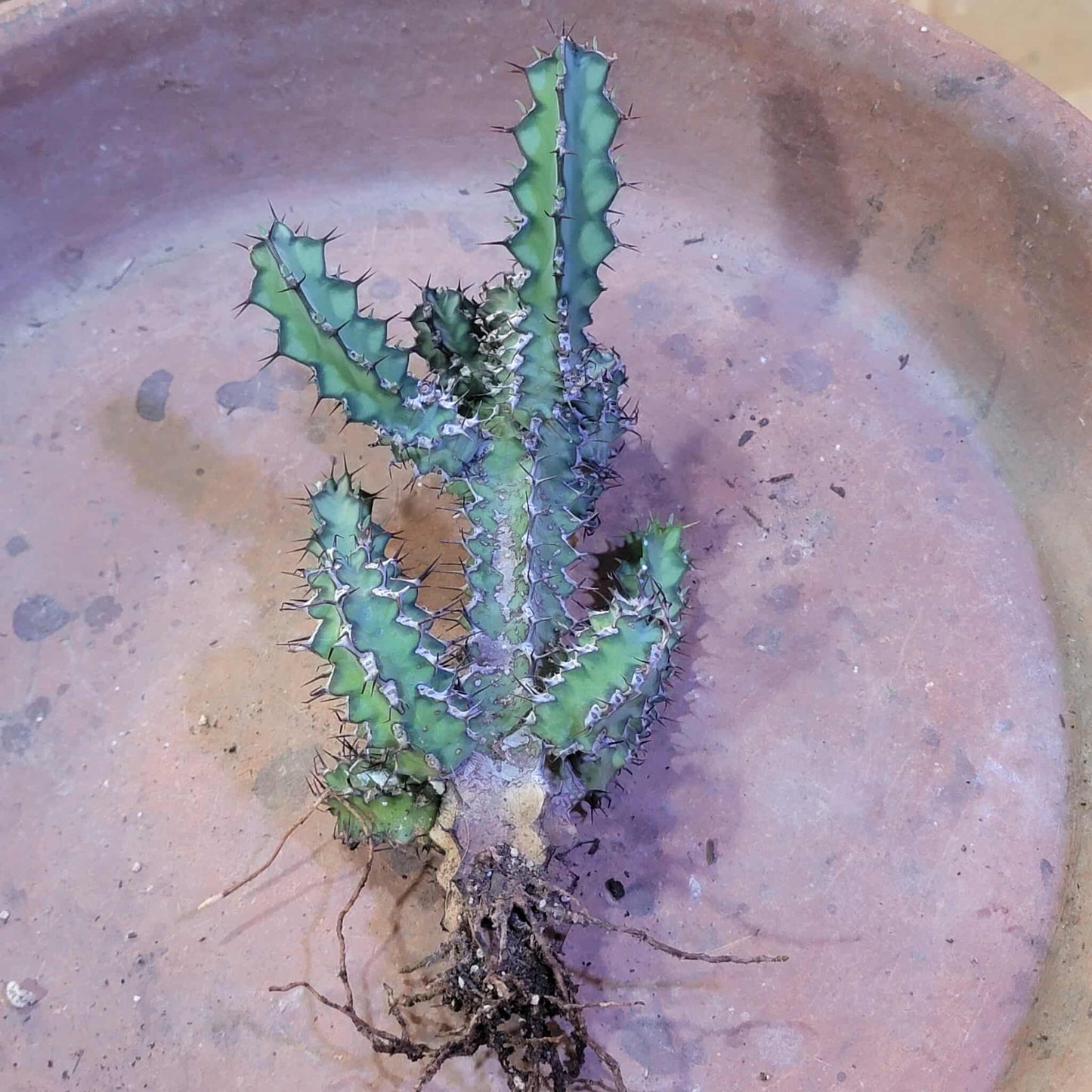Shangri-Ha Cactus Ranch
Euphorbia zoutpansbergensis
Euphorbia zoutpansbergensis
Couldn't load pickup availability
Euphorbia zoutpansbergensis
You will receive a specimen similar to the one shown here.
Measures approximately 6" tall above the soil x 4"w.
Roots as shown.
Showcased here in one-of-a-kind handmade pottery (sold separately).
Will be shipped bare root.
Euphorbia zoutpansbergensis, commonly known as the Zoutpansberg Euphorbia, is a succulent species belonging to the Euphorbiaceae family. It is native to the Zoutpansberg (or Soutpansberg) and Blouberg mountain range in the Limpopo Province of South Africa, where it thrives in rocky, sandstone slopes within lightly wooded mixed savannah at elevations of 1100-1500 meters.
KEY CHARACTERISTICS
· Appearance: This species can be either a small single-stemmed tree or a large shrub, characterized by a dense crown of slender, spreading, and upward-curving branches near the top.
· Size: In its natural habitat, it can reach a height of up to 6-8 meters, but usually doesn't exceed 4 meters. When grown in pots, it generally remains smaller, around 3-4 meters tall.
· Stems: The stems are typically 5 to 7-angled (often 6-angled) and constricted into oblong segments.
· Spines: The angles feature shallow teeth, each with a hard, horny, grey ridge armed with paired spines up to 1 cm long.
· Flowers: It produces small, rounded, brilliant yellow cyathia (false flowers) up to 6 mm in diameter, usually in clusters of one to three along the stem ridges.
· Leaves: Bright green leaves emerge at the growing tips, adding texture and a fresh visual element to the tree's otherwise architectural form. Though often deciduous in dry conditions, its foliage returns with seasonal rains.
· Growth rate: It is considered a moderately fast grower.
· Hardiness: It exhibits some cold tolerance and can withstand temperatures down to –5ºC and even a little snow.
· Drought tolerance: This species is highly drought-tolerant, making it well-suited for xeriscaping or eco-conscious gardening.
· Toxicity: All Euphorbia species, including E. zoutpansbergensis, contain a white milky sap (latex) that can be irritating to the skin and mucous membranes, including eyes and mouth. It is recommended to handle the plant with care, wear gloves, and wash hands thoroughly after contact with the sap.
CARE & CULTIVATION
· Light: Prefers full sun for optimal growth and form. Young plants can tolerate moderate shade but should be gradually acclimated to full sun to prevent scorching.
· Watering: Requires moderate watering during the active growing season (March-September). The soil should be allowed to dry out completely between waterings to prevent root rot. Water sparingly during the winter dormancy period, keeping the soil almost completely dry.
· Soil: Needs well-draining soil, such as a mix designed for cacti and succulents, or a mixture of non-organic materials like clay, pumice, lava grit, and a small amount of peat or leaf-mould.
· Fertilization: Benefits from a balanced fertilizer with high potassium content during the summer growing season. Avoid over-fertilization, as these plants thrive in nutrient-poor conditions.
· Maintenance: Can be pruned for shape and branching. Winter pruning should be avoided for caulescent (stemmed) varieties.
· Propagation: Easily propagated by stem cuttings taken in late spring to summer. Cuttings should be allowed to callus over for 1-2 weeks before planting in well-draining soil.
CONSERVATION STATUS
Euphorbia zoutpansbergensis is listed as "Near Threatened" globally by the IUCN Red List. In South Africa, it is listed as "Least Concern" and is not included in the National Sensitive Species List. The primary threat to this species is habitat loss due to changes in land use. Although succulent collectors pose a slight pressure, the species' remote and inaccessible habitat helps to protect it from over-collection.















